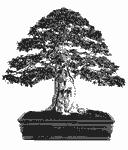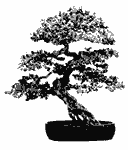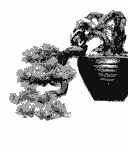5 Main Bonsai Style
There are 5 Main Bonsai Style :
1. Formal Upright
2. Informal Uprigh
3. Slanting
4. Cascade
5. Semi Cascade The Formal Upright. It should have a straight trunk with good taper.
The Formal Upright. It should have a straight trunk with good taper.
To make good formal upright, make sure that about one third of the trunk is visible from the front . The first branch should be at about 1/3 of the total height. The distance between the branches should decrease as you get closer to the top of the tree.
To get reasonable trunk taper can be difficult. However by pruning the top back hard while allowing the bottom branches to grow on you can over the space of a few years induce reasonable taper.
Recommended Species: Bonsai Larches, Juniper Bonsai , Pines , Conifer Bonsai and Spruces Bonsai are all suitable species. Maples can also be used, but are not as easy to train into such a conformist style. Above all, fruiting or naturally informal trees are not suitable for formal upright Informal Upright.
Informal Upright.
To make the Informal Upright style is perhaps the easiest style to get right for the beginner. The trunk should 'flow' unlike the Formal Upright . It bend or alter their direction away from wind or shade other trees, or towards light. In an informal upright bonsai the trunk should slightly bend to the right or left - but never towards the viewer.
The style still requires a tapered trunk, however the trunk direction and branch positioning is more informal and closer to the way a tree would look when exposed to the elements at an early age. The trunk usually takes on an unexpected curve or series of twists and the branches are thus positioned to balance this effect.
The way of developing the trunk on an informal upright is the 'Clip and grow' method, where a tree is allowed to grow away, to thicken up. The tree is then cut back to a few inches, ideally above a bud and then allowed to grow on again. The process is repeated several times, each time the cut is made higher up. In a few years you will have a good trunk and can then set about forming the branches.
Jin (carved remains of dead or unwanted branches to look like dead and rotting limbs of a tree) is also more appropriate and effective with the informal upright style
Recommended Species: Most species of plants are suitable for this style, mainly the japanese maple bonsai (Acer palmatum), Trident Maple (Acer buergerianum), Beech, practically all Conifers and other ornamental trees such as the Crab Apple, Cotoneaster and Pomegranate Slanting styles. Slantingstyles are that a slanting tree will usually have a straighter trunk than an informal tree. Trees that slant naturally occur a result of buffeting winds or deep shade during early development. Whether curved or straight, the whole trunk leans at a definite angle. The stronger roots grow out on the side, away from the angle of the trunk lean, to support the weight.
Slanting styles. Slantingstyles are that a slanting tree will usually have a straighter trunk than an informal tree. Trees that slant naturally occur a result of buffeting winds or deep shade during early development. Whether curved or straight, the whole trunk leans at a definite angle. The stronger roots grow out on the side, away from the angle of the trunk lean, to support the weight.
Recommended Species: Most species are suitable for this style, as the style does bear similarity to informal upright. Conifers work particularly well Cascade Style
Cascade Style
The cascade bonsai reaches below the base of a container. The trunk has a natural taper and gives the impression of the forces of nature pulling against the forces of gravity. Branches appear to be seeking the light. The trunk of a cascade bonsai should come forward of the pot and slightly to one side. Cascades are always planted in deep pots to provide both visual and physical stability.
Recommended Species: Many species are suitable, if they are not strongly upright. Semi Cascade Style.
Semi Cascade Style.
like the cascade, projects over the rim of the container, but does not drop below its base. The style occurs in nature when trees grow on clifs or overhang water. The angle of the trunk in this bonsai is not precise, as long as the effect is strongly horizontal, even if the plant grows well below the level of the pot rim. Any exposed roots should balance the trunk.
Recommended Species: Many species are suitable, except strongly upright ones. Flowering cherries, cedars and junipers work well.
Labels: Bonsai Style



